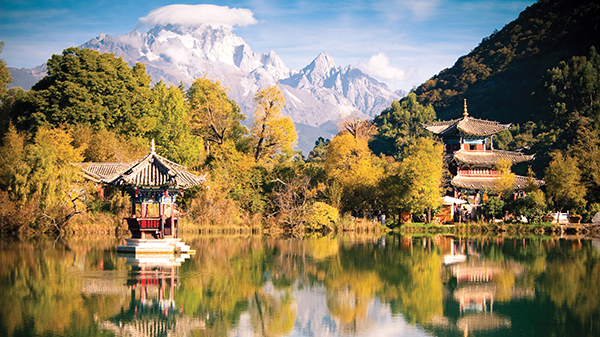There’s something mystical about Lijiang. More specifically, there’s something mystical about the Old Town of this famed Yunnan city. Perhaps it’s the meandering waterways, or the maze of cobbled streets lined with old-fashioned wooden houses. Perhaps it’s the plethora of ethnic-minority folk in traditional costumes. Whatever the case may be, Lijiang’s colourful sights and undeniably nostalgic aura have enchanted and enticed travellers for centuries, and latterly seen it immortalised as a UNESCO World Heritage Site.

The political, commercial and cultural hub of the Naxi people since the seventh century AD, Lijiang subsequently came under the auspices of the Yuan, Ming and Qing dynasties of China. Yet, for many centuries, it was ruled by a single family, the Mu Clan. Thanks to a strategic position along the ancient Tea Horse Road – a network of caravan paths that traversed Sichuan, Yunnan, Burma and the Indian subcontinent – it was a crossroads for multiple ethnicities, and today remains a cultural melting pot that offers fascinating insights into China’s diverse indigenous populations.
Beyond that, however, Lijiang is blessed with splendid natural wonders, be it the soaring Jade Dragon Snow Peak, the impressive Tiger Leaping Gorge canyon or the tranquil Black Dragon Pool. Onward, then, to our round-up of the most visit-worthy spots in this compelling Chinese city.
Heritage Trail

Quaint, charming and romantically nostalgic, the Old Town of Lijiang in modern-day Guzheng district is understandably the city’s biggest tourist attraction. Given the confluence of picturesque waterways, 354 criss-crossing bridges and traditional Ming dynasty (1368-1644 AD) architecture, strolling along its cobblestone streets is akin to being transported back to much simpler times.
A UNESCO heritage location since 1997, it also affords a revealing window into the vibrant cultures of the Naxi, Bai and Tibetan minorities. Visitors can sample local delicacies such as chickpea bean jelly and baba (stuffed flat bread that can be either sweet or salty), and – if they’re lucky – catch a spontaneous circle dance led by women wearing colourful costumes. Trying on and perhaps purchasing these ornate garments is also a highlight of a stay here.
Yunnan Clan

Located within the Old Town, Mufu Palace was once the residence of the Mu family, the hereditary chieftains who ruled the region until 1723. Though little is known about the clan’s origins, they governed the town well before Lijiang was incorporated into the newly risen Ming dynasty in the 14th century. In recognition of their legitimacy under the new regime, the Hongwu Emperor gave its then-leader, A-chia A-te, the Chinese name ‘Mu De’, with ‘Mu’ henceforth becoming the family’s official surname.
In its heyday, the Mufu Palace spanned some 16 acres. Sadly, military battles during the Qing dynasty would see much of its structure razed to the ground. Thankfully, the government initiated a complete rebuilding at the end of the 20th century, and today the complex not only offers an intimate look at both the official and personal quarters of the Mu clan, but also showcases an interesting blend of the Yuan, Ming and Qing architectural styles.
On Dragon Pond

A short walk north of the Old Town lies the resplendent Black Dragon Pool, set against the stunning backdrop of the snow-capped Jade Dragon Snow Mountain – the region’s tallest mountain at 5,596m. Built in 1737, it is officially listed in the government’s ‘Collection of Famous Pools in China’ and is part of the scenic Jade Spring Park. Perhaps one of the town’s most photogenic places, the pond abuts several beauty spots, including the Longshen Temple – also constructed in 1737 – the Moon-Embracing Pavilion and the Forest of Stone Steles. The latter is a museum housing some 3,000 steles – or standing stone slabs – with the most historically significant revealing the evolution of Naxi culture across the ages from the Tang dynasty (618 – 907 AD) to the 20th century.
Leaping Tiger

For those eager to explore beyond Lijiang, a trip to the Tiger Leaping Gorge may be just the ticket. Situated 60km from the town proper, the awe-inspiring gorge stretches some 15km along the Jinsha River, which wends its way between the towering Jade Dragon Snow Mountain and the neighbouring 5,396m Haba Snow Mountain. It is the deepest river canyon in China, with a staggering drop of 3,900m from mountaintop to river bed.
Avid hikers may choose to walk its entire length, but most tourists are drawn to one spot in particular – the narrowest point of the gorge with a boulder perched in the middle. Why, you may ask? Because this is the spot where, according to legend, a tiger being tracked by a hunter found itself trapped between the gushing waters and certain death. In a bid to escape, the feline took a literal leap of faith and reached the other side of the 25m-wide expanse by jumping to and from the aforementioned boulder, thus finding freedom and giving the gorge its name.
Ladies of the Lake

Explorers willing to undertake the four-hour drive to Lugu Lake (on the border of Yunnan and Sichuan) will find their patience rewarded. Known as the ‘pearl of the plateau’, the lake – the highest in Yunnan and the third deepest in China – boasts crystal-clear waters surrounded by verdant mountains. Comprising four peninsulas and six islands, its shores are home to many ethnic minorities, including the Norzu, Yi, Pumi, Tibetan and those close relatives of the Naxi, the matriarchal Mosuo people.
There’s much to see and do here, so opting for at least an overnight stay is highly recommended. Through tour operators in Lijiang, you can arrange such experiences as canoeing through the pristine water, cycling along its perimeter, visiting the various villages that dot the lake’s shores, and partaking in a thrilling bonfire party where the locals don traditional garb and sing and dance into the night. If you’re feeling particularly daring, you can even sample some homegrown spirits, join in the festivities and soak up some of the indigenous Mosuo charm.



